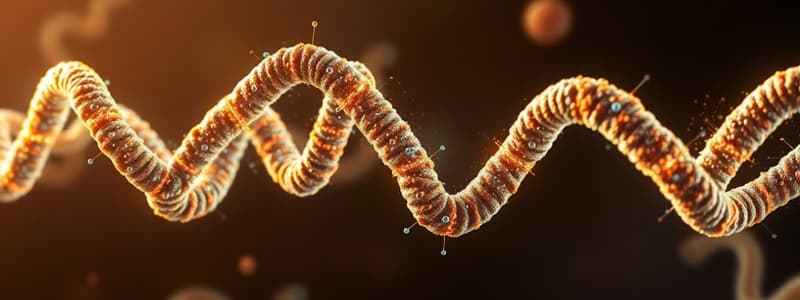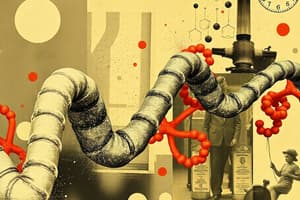Podcast
Questions and Answers
What is the maximum number of different dipeptides that can be formed from 21 different amino acids?
What is the maximum number of different dipeptides that can be formed from 21 different amino acids?
- 21
- 441 (correct)
- 462
- 2100
Which of the following statements is true regarding polypeptides?
Which of the following statements is true regarding polypeptides?
- Polypeptides are linear and cannot form branched structures.
- Polypeptides have fewer than 8 amino acid residues.
- Polypeptides consist of one or more peptide chains. (correct)
- Polypeptides cannot contain peptide bonds.
What is the significance of the resonance in peptide bonds?
What is the significance of the resonance in peptide bonds?
- It increases the flexibility of the peptide chain.
- It causes rigidity in the peptide structure. (correct)
- It permits the formation of cyclic peptides.
- It allows free rotation around the bond.
Which reaction type is involved in peptide bond formation?
Which reaction type is involved in peptide bond formation?
How many different polypeptides can be theoretically formed using 100 amino acids?
How many different polypeptides can be theoretically formed using 100 amino acids?
What determines the rigidity of peptides?
What determines the rigidity of peptides?
Which of the following is NOT considered a type of peptide?
Which of the following is NOT considered a type of peptide?
What is the estimated total number of atoms in the universe in comparison to the number of possible 100 amino acid proteins?
What is the estimated total number of atoms in the universe in comparison to the number of possible 100 amino acid proteins?
What type of molecular link do disulfide bonds create in polypeptides?
What type of molecular link do disulfide bonds create in polypeptides?
Which molecule can be formed through the reduction of disulfides?
Which molecule can be formed through the reduction of disulfides?
Which amino acids are part of the tetrapeptide named alanylserylglycylaspartic acid?
Which amino acids are part of the tetrapeptide named alanylserylglycylaspartic acid?
What is the structural feature of conotoxin G I?
What is the structural feature of conotoxin G I?
How many amino acid residues are present in the conotoxin G I sequence?
How many amino acid residues are present in the conotoxin G I sequence?
What is the role of disulfide bonds in the structure of peptides?
What is the role of disulfide bonds in the structure of peptides?
Which of the following groups of amino acids makes up a heptapeptide as per the provided instructions?
Which of the following groups of amino acids makes up a heptapeptide as per the provided instructions?
What type of peptide bond is to be emphasized when drawing the structure of the heptapeptide?
What type of peptide bond is to be emphasized when drawing the structure of the heptapeptide?
What defines the peptide bond between amino acids?
What defines the peptide bond between amino acids?
Which of the following statements about peptide structure is correct?
Which of the following statements about peptide structure is correct?
What distinguishes a dipeptide from other peptides?
What distinguishes a dipeptide from other peptides?
Which of the following correctly describes a tripeptide?
Which of the following correctly describes a tripeptide?
What is the molecular weight requirement for a molecule to be classified as a protein?
What is the molecular weight requirement for a molecule to be classified as a protein?
What type of linkage is described as occurring between two cysteine units?
What type of linkage is described as occurring between two cysteine units?
Which of the following peptides represents a tetrapeptide?
Which of the following peptides represents a tetrapeptide?
What is the main structural characteristic of polypeptides?
What is the main structural characteristic of polypeptides?
Which statement is true regarding peptide chains?
Which statement is true regarding peptide chains?
Which amino acid primarily contributes to the formation of disulfide linkages?
Which amino acid primarily contributes to the formation of disulfide linkages?
Flashcards are hidden until you start studying
Study Notes
Amino Acids and Peptide Bonds
- Amino Acids can form peptide bonds to create peptides.
- Proteins are molecules made up of one or more polypeptide chains.
- Peptides are chains of amino acids linked by peptide bonds.
- Peptides can be different lengths:
- Dipeptides contain 2 amino acids.
- Tripeptides contain 3 amino acids.
- Oligopeptides contain a few amino acids.
- Polypeptides contain many amino acids (up to 4000).
Peptide Bond Formation
- There are 20 naturally occurring amino acids encoded by the genome.
- Each amino acid can combine with any other amino acid.
- For a 100-amino acid protein, there are 1.27 x 10^130 possible combinations.
- Peptide bonds are formed between the carboxyl group of one amino acid and the amino group of another.
- The peptide bond is an amide bond which:
- Has a partial double-bond character due to resonance.
- Makes the peptide bond rigid and prevents rotation.
- Peptide bond formation is a dehydration synthesis reaction, also known as a condensation reaction.
Properties of Peptides
- Peptides have an N-terminal and a C-terminal.
- The N-terminal is the amino acid with the free amino group.
- The C-terminal is the amino acid with the free carboxyl group.
- Peptides can be classified by the number of amino acids they contain:
- Dipeptide: 2 amino acids
- Tripeptide: 3 amino acids
- Polypeptide: many amino acids
- Protein: 50 or more amino acids
- Peptides are written with the N-terminal on the left and the C-terminal on the right.
Disulfide Bonds in Peptides
- Disulfide bonds are the only other covalent bond between amino acids in proteins and peptides.
- They are formed between two cysteine residues.
- Disulfide bonds can:
- Connect polypeptide chains
- Form a macrocycle within a single polypeptide chain
Conotoxin G I
- Conotoxin G I is a neurotoxin found in the venom of the cone snail Conus geographicus.
- It is a 12-amino acid residue peptide with two disulfide bonds.
- It blocks nicotinic acetylcholine receptors, leading to paralysis.
Studying That Suits You
Use AI to generate personalized quizzes and flashcards to suit your learning preferences.




